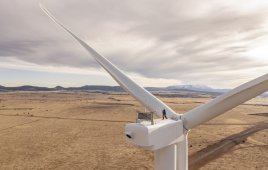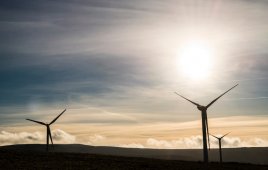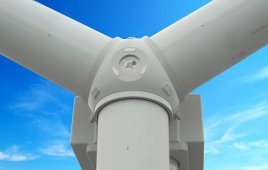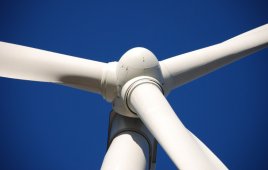If money were less of an object, developers would always put the largest turbines on the tallest towers possible. That would ensure the highest possible capacity factors from about 5-MW units and give a significant boost to power production. It would also, however, be costly. To find the right mix of turbines for the wide range of U.S. climates, turbine OEMs have responded with many focused designs. For example:
Onshore work is likely to fall to 1.5 to 3-MW turbines. In fact, 1.5-MW units seem to be a sweet spot. GE Energy, for example, recently installed its 15,000th, 1.5-MW turbine at Crow Lake wind farm in South Dakota. The feat is testament to the manufacturing idea that if you make enough of something you can drive costs down and quality up. Community-owned wind farms located on islands seem to like the 1.5 to 2-MW units from several manufacturers.
Direct drives may be another trend if neodymium, a material ideal for high-flux-density magnets, says relatively inexpensive. The material recently hit about $140/lb, up from about $70/lb a year ago. Should Chinese sources decide to withhold the material from world markets for internal use, prices will climb further. Then it will be necessary to develop new sources. However, creative electrical engineers have already suggested there are ways to build efficient generators without the material, or less of it.
Low wind speed turbines: This may be the dominant trend. Marketing directors have recognized that there are a lot of moderate wind sites around the globe. Why not a turbine for them? Such units would allow placing turbines closer to loads–cities. Nordex Windpower is just one of several OEMs responding with its N117/2400, a turbine with a 2.4-MW capacity and a relatively large 117-m diameter rotor. The company also plans to mount this unit on a relatively tall 90-m tower.
Craig Christensen, Senior VP of Engineering for Clipper Windpower, says the 105-m rotor on the company’s previous C99 (99-m rotor turbine) will let the machine capture Class III winds with an improved capacity of about 35% (a 30% capacity factor is common) and in Class II winds capacity factors can improve to 40 to 45%. “The effort will require strengthening components all along the drivetrain,” says Christensen. “There’s more to it than a rotor swap.” Electric systems will change least.
The incremental refinements will also allow more reliable working periods after the warranty expires, often a 2 to 5-year period. All turbine manufacturers say they are working on reliability improvements. Christensen says about half his engineering team is working on them. For most turbines, the changes will lower operating costs. Upgrades will span all through the machine, from pitch to hydraulics to yaw and to the gearbox. Suzlon, GE, and Gamesa also have large-rotor units intended for lesser wind regions. Expect larger rotors and taller towers to go together. In the U.S., the 80-m tower is about standard but another 20m will make best use of the larger rotors. In Europe, the 100-m tower is standard.
Christensen identifies another emerging trend: Improved logistics that get components to sites more efficiently. Trucks are about at their load limits so modular designs will be appearing. “That may mean more trucks for a shipment but the components they carry will be more easily handled. Even now, he says, the Liberty 2.5 has been shipping the gearbox and generators separately and assembling them on site.
Upgrades and up-ratings are also the order of the day. It costs millions to develop a new turbine so it makes sense to push existing designs as far as reasonably possible, say from a 1.5 to 2.5, and then to 2.75-MW design.
GE recently commissioned its first 2.75-103 wind turbine at the Energy Research Center in the Netherlands. The new turbine features electrical system uprates and the company’s 50.2-m proprietary blade that it says boosts annual energy production by more than 9% at 7.5 m/s over its 2.5-100 machine.
Larger units: There was a time when 1.5 MW was a large turbine. Today it’s on the small end of the spectrum, as new turbines seem in the 2 to 3-MW range. For instance, Northern Windpower recently announced a manufacturing site for its 2.3-MW direct-drive turbine in Michigan.
Offshore work will fall to the larger units, most from 3.5 to 5 MW. Offshore will likely see large units because of the great effort of working at sea. One 5-MW unit uses a PM generator and a single stage gearbox. Also Vestas recent announced a 7-MW offshore turbine.
WPE
Filed Under: Construction, Towers, Turbines




